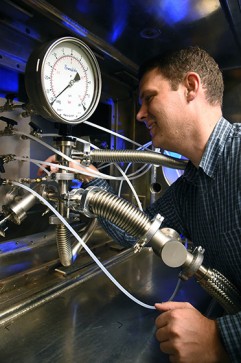
Nuclear fusion laser cleans up coal emissions
The Naval Research Laboratory is developing a low-cost method to reduce nitric oxide and nitrogen dioxide (NOx) emissions from coal power plants. Dr. John Sethian, project leader at NRL, was quoted in a press release on Monday. “This is an important opportunity for NRL to get a technology that we developed here out in the real world, not only to show the technology works, but that NRL’s contributing to cleaner energy.”
NOx emissions contribute to ground-level ozone, pollution, and respiratory problems. The EPA’s current regulations limit NOx emissions to 100 parts per million, and will be lowered to 30 parts per million in the future.
Dr. Sethian and Dr. Matthew Wolford reduce NOx emissions by injecting electron beams into the exhaust of a fossil fuel power plant and breaking apart the NOx bonds to make pure nitrogen and oxygen. The energy from the electron beam shot into the exhaust breaks apart the molecular bonds. Bonds typically break at 4 electron volts of energy, so a pulse that delivers 400,000 electron volts breaks 10,000 bonds.
Utility companies currently use Selective Catalytic Reduction to reduce NOx. The scrubbers are expensive to build and operate. NRL’s new technology is expected to be 10 to 20 percent of the cost of a catalytic scrubber for energy.
Electra, the NRL electron beam system, was originally developed in NRL’s laser fusion program. Fusion is energy released by forcing atomic nuclei together – the same process that powers the sun. Laser fusion uses the inertia of a plasma’s mass to heat and confine the plasma long enough for the nuclei to be forced together.
Achieving a system to reduce NOx could be developed in the next few years. “I think, if we lick the remaining physics and chemistry challenges, we could probably have something ready to field in about two years,” says Dr. Sethian.





